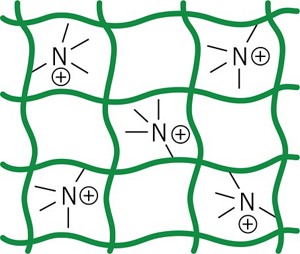Fluorinated gel grabs PFAS
Published on by Water Network Research, Official research team of The Water Network in Academic
New material captures greater share of “forever chemicals” from water than other methods
 This ionic gel with a fluorinated polymer backbone selectively extracts more than 80% of PFAS in contaminated water.
This ionic gel with a fluorinated polymer backbone selectively extracts more than 80% of PFAS in contaminated water.
Afluorinated gel can capture a larger proportion of per- and polyfluoroalkyl substances (PFAS) from contaminated water than currently available techniques ( ACS Cent. Sci. 2020, DOI: 10.1021/acscentsci.9b01224).
PFAS were used as flame retardants and nonstick coatings, but concern over the health risks of these chemicals has grown in recent years, in part because they are extremely resistant to degradation.
US. Credit: ACS Cent. Sci.
Earlier this year, PFAS made headlines because they were found in the drinking water of many cities across the
Removing them is so difficult that scientists have nicknamed them “forever chemicals.” Methods such as granular activated carbon (GAC) and reverse osmosis can capture PFAS but don’t specifically target them. That’s a problem because other chemicals, which are up to eight times as concentrated in ground water, can saturate these technologies before they have the chance to remove a significant quantity of PFAS molecules.
Frank A. Leibfarth and Orlando Coronell of the University of North Carolina at Chapel Hill and colleagues created a fluorogel resin with chemical properties designed to ensnare PFAS. “I was scared the entire time we were doing the project that someone would publish something similar; the idea is quite logical,” Leibfarth says.
PFAS contain a fluorinated carbon chain with a negatively charged end group, so the researchers created a polymer with a fluorinated backbone and positively charged components that would bind to PFAS molecules. They first tested the gel in the lab with water artificially spiked with PFAS.
After 21 h, the material had captured more than 80% of the PFAS. It proved equally able to remove PFAS from settled water collected from a treatment plant—demonstrating that the gel absorbed PFAS specifically and did not become clogged up by other chemicals or particulate matter in the mix. These results outperform existing technologies. GAC, for example, seizes roughly 40% of PFAS under the same conditions, Leibfarth says.
The ratio of charged ionic parts to fluorinated parts can be customized to target specific PFAS. “Our resin is better for short-chain PFAS, which are the ones that GAC and other technologies struggle with,” Leibfarth says.
The technology could be used in water treatment plants, but the researchers hope eventually to create an under-the-sink device to filter domestic water, which could serve households that rely on well water. Leibfarth says his number one priority is now to assess the chemical stability of the resin and incorporate these results into subsequent design.
Selma Mededovic, a chemical and biomolecular engineer at Clarkson University, welcomes the new research but says it’s important to remember that it only solves half the problem. “You found a way to collect waste—now what are you going to do with it?” she asks. “The real problem is how to destroy [the PFAS] once you’ve captured them because almost nothing can degrade them.”
That’s a fair criticism, Leibfarth says, but one that other capture technologies also face. For now, he’s rinsing the captured PFAS from the fluorogels and concentrating them in a methanol solution.
Taxonomy
- Purification
- PFAS